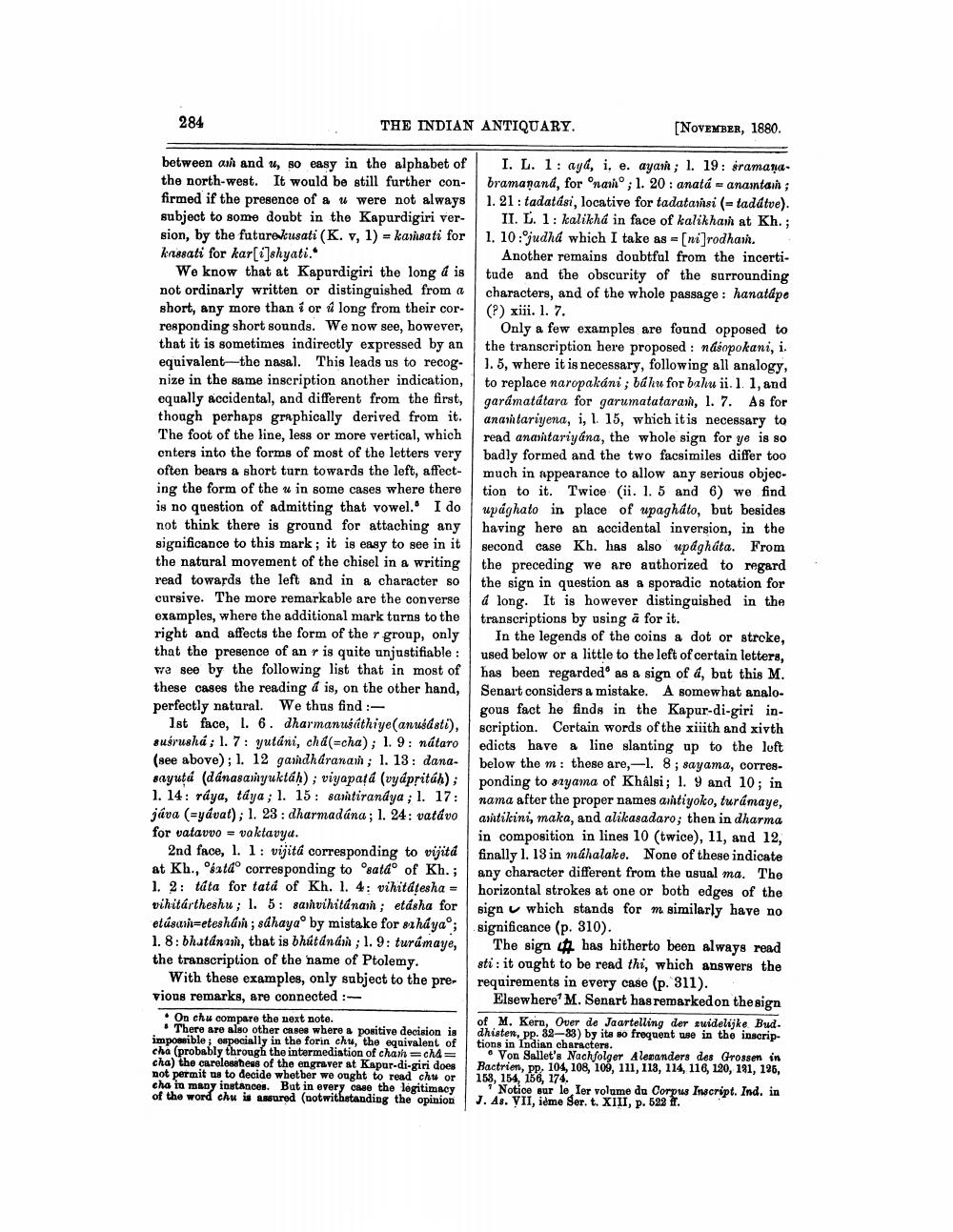________________
284
THE INDIAN ANTIQUARY.
[NOVEMBER, 1880.
between ash and , so easy in the alphabet of I. L. 1: aya, i. e. ayan; 1. 19: sramanathe north-west. It would be still further con- bramanand, for Onanio; 1. 20 : anatá = anantain; firmed if the presence of a “ were not always 1.21: tadatási, locative for tadatansi (= tadátve). subject to some doubt in the Kapurdigiri ver- II. L. 1: kalikha in face of kalikhain at Kh.; sion, by the future usati (K. v, 1) = kasati for 1. 10: judhd which I take as = [ni]rodhani. krasati for kar[C]shyati..
Another remains doubtful from the incerti. We know that at Kapurdigiri the long distude and the obscurity of the surrounding not ordinarly written or distinguished from a characters, and of the whole passage: hanatápe short, any more than 1 or ú long from their cor- (?) xiii. 1. 7. responding short sounds. We now see, however, Only a few examples are found opposed to that it is sometimes indirectly expressed by an the transcription here proposed : násopokani, i. equivalent—the nasal. This leads us to recog- 1.5, where it is necessary, following all analogy, nize in the same inscription another indication, to replace naropakáni ; báhu for balu ii. 1 1, and equally accidental, and different from the first, garámatátara for garumatatarai, 1. 7. As for though perhaps graphically derived from it. ananitariyena, i, l. 15, which it is necessary to The foot of the line, less or more vertical, which read anahtariyána, the whole sign for ye is 80 onters into the forms of most of the letters very badly formed and the two facsimiles differ too ofton bears a short turn towards the left, affect- much in appearance to allow any serious objec. ing the form of the win some cases where there tion to it. Twice (ii. 1. 5 and 6) we find is no question of admitting that vowel. I do upághato in place of upaghato, but besides not think there is ground for attaching any having here an accidental inversion, in the significance to this mark; it is easy to see in it second case Kh. has also updghúta. From the natural movement of the chisel in a writing the preceding we are authorized to regard read towards the left and in a character so the sign in question as a sporadic notation for cursive. The more remarkable are the converse a long. It is however distinguished in the oxamples, where the additional mark turns to the transcriptions by using a for it. right and affects the form of the r group, only In the legends of the coins a dot or stroke, that the presence of an r is quite unjustifiable : used below or a little to the left of certain letters, wa see by the following list that in most of has been regarded as a sign of d, but this M. these cases the reading 4 is, on the other hand, Senart considers a mistake. A somewhat analoperfectly natural. We thus find :
gous fact he finds in the Kapur-di-giri in1st face, I. 6. dharmanusathiye(anusdati), scription. Certain words of the xiiith and xivth suárushá; 1. 7: yutáni, chd(=cha); 1. 9: nátaro edicts have a line slanting up to the loft (see above); 1. 12 gandháranan; 1. 13: dana- below the m: these are,-1. 8; sayama, corressayuta (danasayuktah); viyapatá (vyápritán); ponding to sayama of Khálsi; 1. 9 and 10; in 1. 14: ráya, taya; 1. 15: santirandya; 1. 17: nama after the proper names aintiyoko, turámaye, jáva (=yávat); 1. 23: dharmadána ; 1. 24: vatávo ashtilini, maka, and alikasadaro; then in dharma for vatavvo = vaktavya.
in composition in lines 10 (twice), 11, and 12, 2nd face, l. 1: vijitá corresponding to vijita finally 1. 13 in máhalake. None of these indicate at Kh., satúo corresponding to osata of Kh.; any character different from the usual ma. The 1. 2: táta for tatá of Kh. 1. 4: vihitadesha = horizontal strokes at one or both edges of the vihitártheshu ; 1. 5: sanvihitánan; etásha for sign which stands for m similarly have no etásax=eteshári ; sáhayao by mistake for er háyao; significance (p. 310). 1. 8: bhatánar, that is bhátánám; 1. 9: turúmaye, The sign has hitherto been always read the transcription of the name of Ptolemy. sti: it ought to be read thi, which answers the
With these examples, only subject to the pre- requirements in every case (p. 311). vious remarks, are connected :
Elsewhere' M. Senart has remarked on the sign • On chu compare the next note.
of M. Kern, Over de Jaartelling der suidelijke Bud. . There are also other cases where a positive decision is dhister, pp. 82-83) by its so frequent use in the inscripimpossible; especially in the forin chu, the equivalent of tions in Indian characters. cha (probably through the intermediation of chanh cht= Von Sallet's Nachfolger Alexanders des Grossen in cha) the carelessness of the engraver at Kapur-di-giri does Bactrien, pp. 104, 108, 109, 111, 113, 114, 116, 120, 181, 136, not permit us to decide whether we ought to read chu or 153, 154, 156, 174. cha in many instances. But in every case the legitimacy Notice sur le Ier volume du Corpus Inscript. Ind. in of the word chu is amurod (notwithstanding the opinion J. 48. VII, ieme Ser, t. XIII, p. 592 fr.




